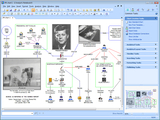PROBAS:
Probabilistic decision-making based on Arguments and Scenarios
Bayesian networks (BNs) provide decision support in complex investigative domains where uncertainty plays a role, such as medicine, forensics and risk assessment. Yet, BNs are only sparsely used in practice. In data-poor domains, they have to be manually constructed, which is too time-consuming to support pressing decisions. Furthermore, few domain experts have the mathematical background to build a BN, a graph representing dependencies among variables with probability distributions over these variables. So despite the increased analytical power a BN could bring with respect to, for example, evidence aggregation or sensitivity analysis, many experts still use more qualitative concepts such as scenarios (stories, cases, timelines) and arguments (evidence graphs, ordered lists), which convey verbally expressed uncertainty ("strong evidence", "plausible scenarios").
If BNs are to be used in actual investigations, we need software tools and interfaces for BN construction that are engineered into the heart of the decision-making process. These tools should be based on familiar, more linguistically-oriented concepts such as arguments and stories, and complemented by algorithms intended to speed up and facilitate the BN-building process.
How are arguments and scenarios used in actual decision-making under uncertainty?
We will perform an ongoing case study at the Dutch Police on investigation and operational risk assessment. Through expert interview and case analysis, we will investigate the ways in which scenarios, arguments and uncertainty are used in existing decision-support processes and tools.How can arguments and scenarios be used to construct and compare (partial) BNs?
We aim to design knowledge-elicitation techniques based on scenarios and arguments. First, the scenarios and arguments constructed by experts using existing tools convey information about relations and uncertainties, which we intend to use to derive constraints on the graph and the probability distribution of a BN. Second, we also aim to design argumentation protocols and schemes for discussions about BNs, which can be used to elicit further constraints and resolve conflicts among domain experts.- A preliminary first step is described in our COMMA 2016 paper.
How can we use mathematical and computational techniques to refine and choose between constructed BNs?
Due to their more qualitative nature arguments and scenarios often do not convey enough information to build a complete BN – the most common problem is finding all the necessary probabilities. We therefore aim to mathematically study the relations between consistent second order distributions on possible BNs and the constraints derived from arguments and scenarios. In addition, we will design computational techniques for comparing alternative BNs under construction, using comparison measures such as difference in outcomes, complexity and robustness.The knowledge elicitation techniques and algorithms developed will be implemented in software services that connect to existing and new interfaces at the Dutch police. Results from BN comparisons can then indicate the domain knowledge necessary for further model selection, and argumentation interfaces can be used to elicit sufficient constraints to reduce second order uncertainty among the possible models as much as possible.

